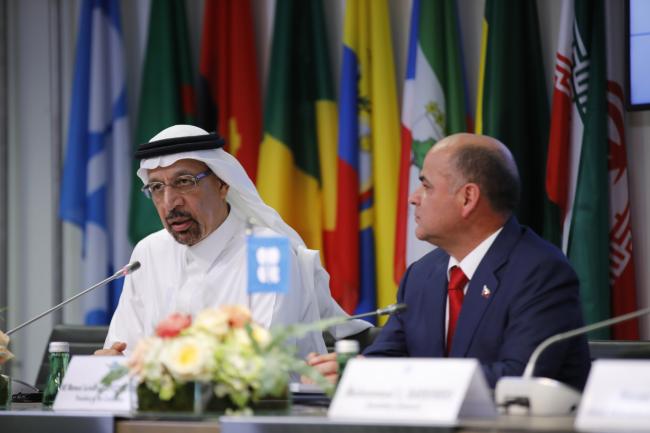(Bloomberg) -- Saudi Arabia, OPEC’s dominant producer, will keep doing the heavy lifting as the cartel and its allies were all but forced to extend their effort to counter the U.S. shale boom into a fourth year.
In a meeting on Tuesday, the Organization of Petroleum Exporting Countries and 10 non-members including Russia rubber stamped the cartel’s earlier decision to continue production limits for another nine months. For all the expressions of unity, one country mattered more than the others.
Saudi Oil Minister Khalid Al-Falih used a press conference on Monday night to say the kingdom was willing to keep cutting more deeply than its quota requires.
“This is a commitment to reduce inventories, and whatever it takes for them to do it,” said Amrita Sen, chief oil analyst at Energy Aspects Ltd. The Saudis are likely to keep production at around 10 million barrels a day -- below their target -- and “if required after nine months, they will continue with the deal.”
Al-Falih, who back in 2016 suggested supply reductions by Saudi Arabia, Russia and other producers in the OPEC+ coalition would only be needed for six months, appears increasingly bogged down in a struggle to wrest control of the global oil market from the U.S. shale industry. He expects to win, but conceded it will take a long time.
“I have no doubt in my mind that U.S. shale will peak, plateau and then decline like every other basin in history,” Al-Falih told reporters at OPEC’s Vienna headquarters. “Until it does I think it’s prudent for those of us who have a lot at stake, and also for us who want to protect the global economy and provide visibility going forward, to keep adjusting to it.”
OPEC and its allies could be in for a decade-long fight. U.S. shale output will keep growing until the early 2030s, according to estimates from Rystad Energy A/S, an Oslo-based consultant that has been a staunch believer in the American energy boom.
The long-term nature of Saudi Arabia’s commitment was also signaled by two other decisions during this week’s meeting. First, making the cooperation with Russia and other countries in the OPEC+ coalition more formal by adopting a charter to govern the relationship. Second, Saudi Arabia proposed a more ambitious target to reduce global stockpiles.
Saudi Arabia said it would measure the surplus of crude inventories against the 2010-2014 average rather than the same measure over the last five years. That would mean draining an additional 160 million barrels from the world’s oil tanks, based on calculation by Bloomberg News. Russia promised to study the Saudi proposal.
“Inventories have gone out of our hands the last few months,” Al-Falih said “It’s unfortunate but they did.”
The initial reaction to OPEC’s decision was modest, suggesting investors remain worried about the outlook for global oil demand during the rest of the year and into 2020. Brent crude was down 0.3% at $64.89 a barrel at 11:43 a.m. in London on Tuesday. That’s about 2.5% below the closing price on Friday, before the cuts extension was announced.
The decision to extend production curbs through next March comes as the International Energy Agency and other market watchers peg back forecasts for demand amid sluggish growth in China and India. But Al-Falih said concern about slowing oil demand was overdone, especially after China and the U.S. agreed on a trade war truce at the G-20 summit in Osaka.
Hours of Wrangling
Although the deal was adopted swiftly on Tuesday, talks between ministers on Monday weren’t without drama.
The OPEC members quickly settled on extending their output cuts, but the talks dragged on for hours longer than anticipated amid wrangling between Iran and other countries over the details of the charter enshrining the OPEC+ alliance.
Since OPEC joined forces in 2016 with other producers including Russia, Kazakhstan and Mexico, they have sought to establish an enduring basis for cooperation. But Iran has voiced unhappiness with the dominance that non-member Russia -- not to mention regional rival Saudi Arabia -- exert over OPEC policy.
Iranian Oil Minister Bijan Namdar Zanganeh said the dispute was resolved by making sure the charter doesn’t change OPEC’s decision-making process, and giving national governments the right to approve the document.
Ministers are likely to insist the end is in sight but based on past experience, oil traders may be skeptical that the cuts will come to an end any time soon. In late 2016, the group announced the cuts would last just six months. Then in mid-2017, it prolonged the cuts by nine months, only to extend them by a further nine months at its next meeting.
